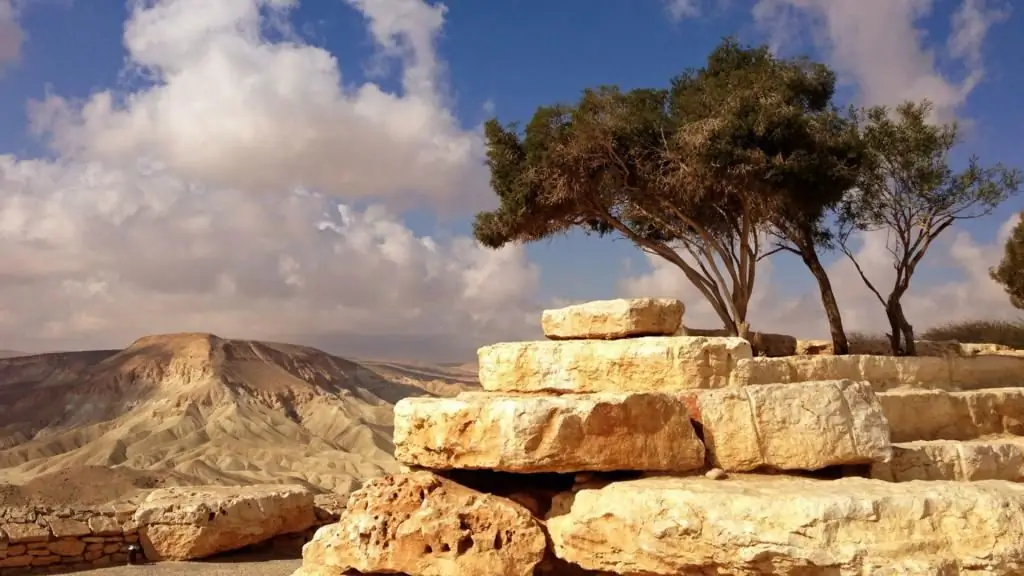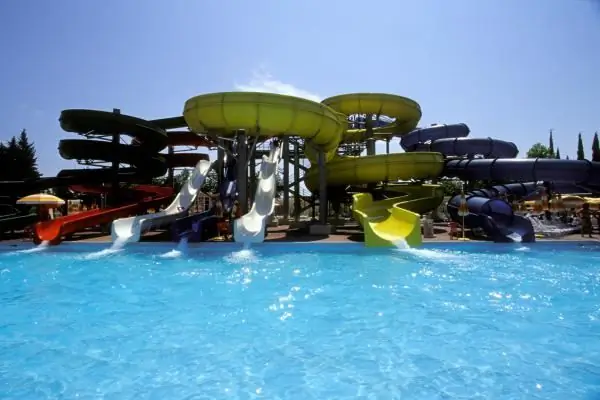- Author Harold Hamphrey [email protected].
- Public 2023-12-17 10:06.
- Last modified 2025-01-24 11:10.
One of the sights of the B altic is the Efa dune. This is a large sandy ridge stretching for 4.5 kilometers along the Curonian Lagoon. This dune is the largest in Europe, therefore it attracts many tourists from neighboring Lithuania, the Kaliningrad region, and from all over Russia and Europe.
What is the dune of Efa
Actually, this is a large mountain of sand, which is actually called Walnut. However, more often it is called by the name of the highest point - the height of Efa, which, by the way, rises up to 64 meters. The dune starts at about 16 km of the Curonian Spit and stretches to the very border with Lithuania.
Hiking trails are laid along the entire length of the spit. Desert landscapes are picturesque: the sky, the waves of the bay and the vegetation - this is what makes the Efa dune unique. The Curonian Spit is also a place of bird migration, for example, at the end of summer and autumn you can meet a lot of gulls here. By the way, there is also an ornithological station nearby, where birds are ringed. But besides the seagulls, there is something to see here.

Fortification history"dancing" sands
Efa dune was once surrounded by trees, but they were cut down in the 18th century. Why, why and who - these questions history has no answer. But everyone knows exactly what happened after - the sands, no longer held back by the roots and trunks of trees, commanded by the force of the wind, began their free movement. Over the years, they destroyed 14 surrounding villages - the sand slowly penetrated the houses, fell asleep in the cracks and gradually crushed everything under it. It is said that local houses even had double doors - if the sand began to prop it up, one narrow door could be opened.
Dune protruded 20 meters in a year. People were unable to stop this natural phenomenon and simply abandoned their houses and moved away. Soon the sands began to threaten not only the villages, but also shipping, as well as rich fisheries. Therefore, in 1768, Europe decided to fight against the elements. Nobody knew how, so they announced a competition for the best solution to the problem. Professor Titius won, who proposed to return the spit to its original form and plant it with trees again. For this, cages were built from dry reeds, which trap the sands and allow the dune to grow upward. When the desired height is reached, grasses are planted in similar cells that grow well in the sun and have long roots that hold the dune in one place. And then they plant shrubs and pines, which help the common cause with their roots.

The work spanned over 100 years, 40 of which were managed by arborist and dune inspector FranzEfa, it was in his honor that the highest point of the dune was named. He deserved such gratitude from the inhabitants of the local village of Pillkoppen (now it belongs to Russia and is called Morskoy). It was Ef's contribution that stopped the advance of sand on the village and saved its inhabitants and houses. There was even a memorial plaque dedicated to the arborist on the dune, but today it is gone.
To date, the afforestation of the dune is still ongoing, about 15 percent of all sands remain to be planted. Although, according to some reports, this 15 percent is the most mobile dune of Efa, which was left as a highlight of this place. Like Efa's twig cages, modern technology would have supported the sands without them, but the facility's uniqueness encourages it to be preserved as it was intended a century ago.
Hiking not on special flooring is strictly prohibited here and punishable by a fine. However, the reality is that tour groups enter the dune just below the prohibition signs and descend to the bay, risking destroying two centuries of long work.
What to see
The most important thing that the dune of Efa offers is natural attractions, namely breathtaking views. For admiring nature, two viewing platforms have been created here. From here you can enjoy amazing views of the Curonian Lagoon, the B altic Sea on the other side, the village of Morskoy and the alien landscapes of the dune itself.
When the wind picks up in good sunny weather, millions of grains of sand in the air create the feeling of being in a real desert, as if caught in a sandstorm. It's amazingsensations for the B altic region.

Staroselskaya mountain is visible from the first observation deck. Here (according to legend) the local Curonians worshiped their pagan gods, and the Crusaders built a fortress for themselves in the 18th century. But all this is buried and destroyed by wandering sands. From the second platform you can also see Morskoye - a picturesque village with houses under a red tiled roof.
Hiking trails
Since it is strictly forbidden to walk along the dune itself, wooden platforms are installed along it, along which you can take a walking tour. The length of the path is about 2.8 kilometers, the whole journey will take approximately 2 hours.
The entrance to the trail starts at the 42nd kilometer of the dune and is marked with a sign, but it is difficult to drive past - there are always a lot of tourists, cars and buses, souvenir tents. The route is called “Ef Height” and it is laid along the southwestern slope of the dune.
So, the route begins in a forest clearing, passing through which only 200 meters, you can climb to the first observation deck. A wooden staircase leads to it along a very picturesque pine forest. The second platform is set a little further, at the highest point of the dune. Keep in mind that the area is small and the stairs leading up to it are narrow. In the season, due to the large number of tourists, it will be difficult to go down and up on it.

Features of visiting
Because Efa dune is a national park, you need a pass to visit it by car. It is issued at the checkpoint of the park. Access to the territorycosts 250 rubles.
The weather in the B altic is very changeable - the rains are replaced by the sun, and vice versa, so bring an umbrella or a raincoat, as well as a cap and sunglasses, in any weather to see the local sands that make the Efa dune unique. Reviews from tourists and locals say: if you don't like the weather, wait five minutes. However, even if you like it, everything can change in five minutes.

The tourist trail laid on a wooden platform is rather narrow, the flooring is old and rotten in places, so look under your feet. In addition, it can be slippery after rain or fog.
Dune Efa: how to get there
You can come to see the Efa dune by car. If you drive from Kaliningrad, then in front of Morskoy, to the right of the road, there will be a sign.

You can also come by bus from Kaliningrad. There is a route directly to Morskoye, but it rarely runs, so you can get to Zelenograd and there transfer to the Zelenograd-Morskoye bus. By the way, large regular buses on this route travel longer than small minibuses.
Where to stay
You can stop for the night to see the dune and the entire Curonian Spit in Kaliningrad or in the village of Morskoe. The city has many offers for accommodation - from luxury hotels to inexpensive hostels and private apartments. Morskoe, as the reviews say, is an actively developing tourist village where it is pleasant to relax. There are many boarding houses and recreation centers that are open all year round.






